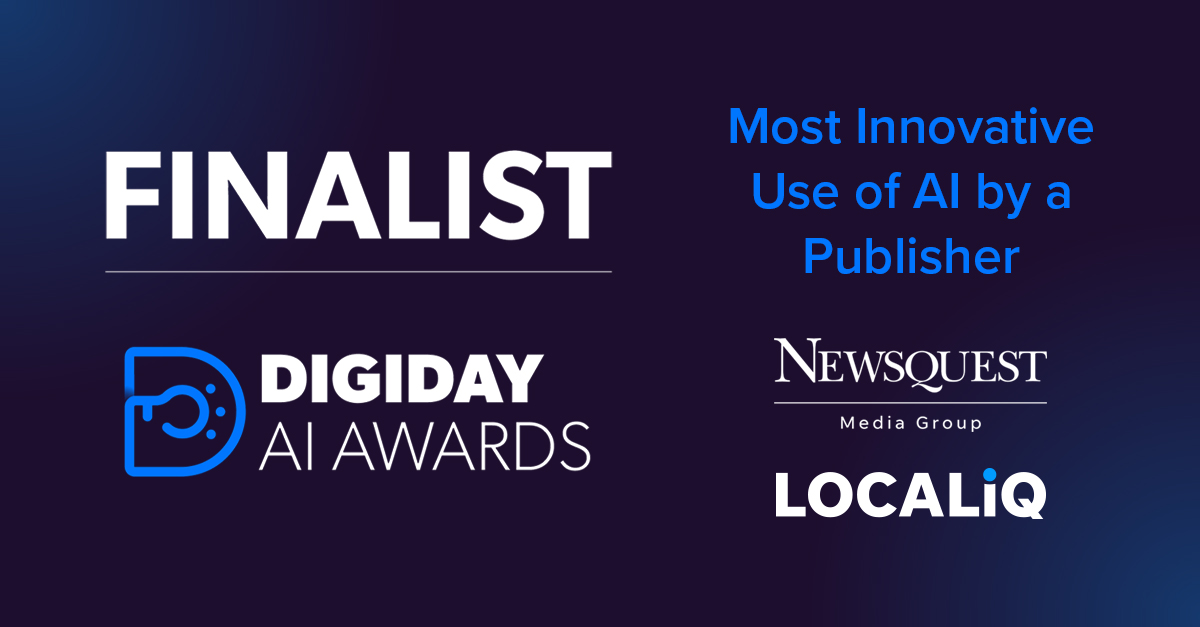A well-optimised campaign can help you bring in more leads for your business whilst reducing costs. By implementing some of the techniques in this article, you’ll be able to optimise campaigns to meet your marketing goals.
In this blog, we will cover:
- What is campaign optimisation?
- Why is campaign optimisation important?
- How frequently should you optimise your digital ad campaigns?
- What are some of the best methods for optimising ads?
- Optimisation types
- LOCALiQ campaign optimisation management
- LOCALiQ Client Centre
What is campaign optimisation?
Campaign optimisation is a strategy used by marketers to boost the effectiveness of marketing or advertising campaigns. In terms of advertising or marketing, it enables advertisers to achieve the best possible results. Campaigns can be optimised for particular objectives like website clicks, engagement, reach or conversions. For example, if your campaign was designed to gain more website clicks, the publisher would strive to maximise website clicks while minimising expense.
When starting an advertising campaign, publishers like Facebook and Google Ads enable their advertisers to switch optimisation on and select the goal for which they would like to optimise their campaign. Some businesses and agencies, like LOCALiQ, have their own optimisation technologies and processes, which will further improve the performance of your campaign on these publishing sites.
Why is campaign optimisation important?
Not only will it help you meet your objectives, but it’ll also ensure your adverts are up-to-date and relevant. You must take action to make sure your advertisements are in line with best practices for maximising audience reach if you want to get the best return on ad spend (ROAs).
How frequently should you optimise your digital ad campaigns?
You should only perform significant optimisations every six months or so for a campaign to be successful. You can make changes to a campaign as often as you’d like if it’s not working.
Remember: Give your campaign enough time to run before you start making changes so you can see trends. it could take some time before a campaign starts to succeed.
What are some of the best methods for optimising ads?
Making use of different types of engaging media throughout your campaign and matching your campaign to your customer’s buying journey are some of the greatest techniques for ad optimisation, and of course, keeping tabs on the success of your campaign.
Now that you know what campaign optimisation is, let’s explore the steps you may take to improve the advertising campaigns that will help you maximise your return on advertising spend (ROAs).
Steps for optimising your ad campaigns
1. Plan
Always perform some preliminary research on the offer and the competition before launching a campaign. This will allow you to build a clear route for optimisation and avoid unnecessary mistakes by correctly setting up your campaigns.
Remember: You should never overlook the importance of carefully planning your campaigns!
2. Compile data
You need enough data from a campaign before you can start optimising. As a result, let your campaign run and monitor the data you are gathering. It is risky to optimise too fast because you risk missing out on reliable traffic resources.
3. Build multi-channel advertising campaigns
Customers can communicate with businesses on a variety of channels these days. As a result, they can begin their journey on one channel, go along it on another one and end it on a different one again. By developing multi-channel campaigns, you must optimise to raise your conversion and sales chances. Multiple distribution and marketing channels are combined into a single, cohesive consumer acquisition approach in multi-channel advertising campaigns. The following are the key benefits of developing a multi-channel campaign:
- By reusing media across channels, saving you time and also money.
- Giving customers a seamless transition between channels.
- Expanding your audience reach.
One of the best ad campaign optimisations tricks is to establish a multi-channel campaign, which enables you to tell a consistent brand story across several channels. This makes it simple for customers to recognise your brand when they see your advertisements, which is crucial to turning a lead into a sale. So, how should your multi-channel advertising strategy be designed and optimised?
- Recognise your target demographic’s preferred channels.
- Set goals for your campaign.
- To gauge progress, choose significant key performance indicators.
- Create messaging that is consistent and tailored to each channel.
- To track attribution and measure effectiveness, use programmes like Google Analytics (GA).
Since there are so many moving parts, creating an effective multi-channel campaign involves careful planning and some effort. You will surpass the competition if you can successfully implement your multi-channel ad campaign approach.
4. Track campaigns for insights
You need benchmarks if you want to optimise your advertising strategies. You also require a plan to monitor and evaluate your campaign’s success. Fortunately, there are several methods you can utilise to gain instantaneous insights about the success of your advertising campaigns. But how does this assist in maximising your advertising campaigns?
Monitoring pertinent campaign KPIs enables you to understand:
Performance of keywords: Finding the correct keywords is essential for effective advertising efforts. You can quickly alter your target keywords if you notice that they aren’t bringing in relevant traffic.
Content types and media your audience prefers: You may learn which media types increase engagement and conversions by A/B testing campaigns with various media and content kinds.
Behavioural patterns of audiences: You can examine audience behaviour and determine which aspects of your advertising campaign your target audience is not responding to by using specific tools.
A channel’s attribution: Understanding how each channel performs in attracting customers to your offer is one of the most important components of improving your ad campaigns. You can now concentrate more efforts on these channels as a result. Excellent examples of technologies that can assist with attribution include Adobe Analytics and Google Attribution.
5. Consider your buyers’ journey in your ad campaigns
Effective marketing initiatives aren’t brand focused. They put the client first. You must therefore develop an advertising strategy that is in line with your buyer’s journey.

Image Source| LOCALiQ.
The steps prospects take to become customers are referred to as the buyer journey. There are typically three distinct stages:
- Awareness: Your potential customer is now aware of the issue your product or service addresses. Create individualised ad content that raises awareness of agitation around this issue. As your audience scrolls through information on the platforms you are advertising on, visually appealing content is also beneficial in this situation.
- Consideration: Your prospect begins to think of remedies for the issue. Here, advertisements that show you can resolve an issue for your target demographic are the most effective. To interact with users who have previously viewed your content or advertisements, you may also run retargeting ads here.
- Decision: Your prospect is deciding which provider is most suited to solve their problem at this point in the buying process. Here, you must produce content that assists clients in making wise choices.
You must take into account these stages and tailor your efforts to each one to create efficient ad campaigns. You must approach multi-channel campaigns similarly if you want to successfully align your ads to each stage. The only difference is that you produce distinct ads targeting distinct consumers at distinct touchpoints in the buyer experience rather than using the same advertisement across several media. As it helps you to create targeted and personalised ads and messaging, matching your ad strategy to your buyer journey is crucial to optimising your ad campaigns. Better performing advertising and thus higher conversion rates are the end outcome.
6. Multi-media planning in your ad campaigns
For your advertising strategies to be effective, media is essential. For a single campaign, you might opt to use a variety of media formats to ensure an interesting and productive consumer journey. For instance, you might create a campaign that combines several elements like an advertisement, landing page, YouTube video, etc. The campaign’s effectiveness depends on how well you manage the consistent flow of your media assets across several channels.
Your engagement and conversion rates will suffer if your customers become perplexed as a result of your media assets being inconsistent across platforms. A solid media planning approach is required.
7. Centralise your product catalogue for ad campaigns
Keeping a central product library is a frequently forgotten yet crucial component of improving your ad campaigns. This is an online repository for all of your available products, along with descriptions and prices. How can this help you optimise your advertising campaigns? You can quickly set and display products (and prices if you wish) in a centralised product catalogue, and you can use that information in your advertising efforts. Your clients will have a better enjoyable experience as a result because it gives them all the crucial information, they need to make decisions.
It is simpler to see and select the products you want to highlight in your advertising campaigns when there is a single, consolidated product catalogue. It’s especially useful for managing campaigns across multiple channels because you can quickly match product photos to the most effective channels. The ability to expedite some of your ad creation chores is another reason why having a centralised product library is essential for optimising your advertising efforts. Without one, modifying the product-specific elements of your advertising campaigns would require you to go through time- and resource-wasting ineffective processes.
A well-organised consolidated product catalogue is crucial for ensuring that any changes to your product inventory appear in your adverts. With one, it is simpler to monitor and manage. This guarantees that your clients always receive accurate information.
8. Analyse your key performance indicators
As mentioned above, you should choose significant KPIs for your campaigns if you want to see any progress. To start with, you need to know where to look to evaluate the effectiveness of your advertising. Next, decide the key performance indicators for the digital campaign: cost per lead, engagement rate, number of leads, click-through rate (CTR), the number of served impressions, unique visits to the website or landing pages, etc.
Measuring brand marketing goals with KPIs
KPI metrics for brand awareness typically include the following:
Awareness
- Impressions
- Click-through rate
- Unique users
Consideration
- Video watching time and completion rate
- Time on site
Conversion
- Click-through rate
- Clicks
- Sales
Tools for Measuring KPIs
There are many tools available to you to gauge the success of your campaign. For instance, the number of unique users you receive during the campaign can be measured in Google Analytics. Additionally, you may examine the bounce rate, average time spent on a page, and other analytics to see how effectively your advertising landing page performs.
Conversion rate is one of the most crucial metrics you must track in Google Analytics. When your target audience is already familiar with your brand or product, they have trust in you, and they can easily purchase from you. Conversion measurement is typically used for cost-per-click (CPC) performance campaigns. So, the goal of your campaign will be to increase conversions.
Awareness
- Impressions
- Unique users
Consideration
- Video watching time
- Video completion rate
- Time on site
Conversion
- Click-through rate
- Clicks
- Sales
Optimisation types
Here are a few different types of optimisation.
Conversion-based optimisation
Conversion-based optimisation also known as the cost per acquisition (CPA) or cost per lead (CPL) model, refers to the use of smart technology within the campaign that will work towards bringing in the most conversions for your campaign’s budget and duration. In other words, by maximising the effects and results of your campaign, using technology.
When you integrate optimisation capabilities into a campaign, you can choose which goal you’d like the technology to optimise for, such as clicks, reach, engagement, or leads and conversions. Conversion-optimised marketing campaigns are used by LOCALiQ. Our search, social, and content campaigns are optimised for our clients. Let’s see how we do it.
Search engine marketing campaign optimisation
At LOCALiQ, we use our own unique application programming interface (API) that integrates with Google and Bing to use conversion-based optimisation. We create and place a small snippet of HTML code, which is implemented into the header of your website. This connects your search engine marketing (SEM) campaign on Google and Bing to our optimisation system.
We manage numerous search engine marketing campaigns (also known as pay-per-click) for our clients, and we optimise them to generate the most leads at the lowest cost per lead. Without guessing or human intervention, our intelligent, proprietary optimisation technology automatically makes changes to your campaign to ensure it is running at the most optimal level possible.
Our SEM campaign optimisation includes allocating the budget automatically to the keywords and search engines that are driving the most online conversions, such as form films, emails, calls, etc. With our technology, your campaign’s keyword bids are optimised twice daily. The bids are increased on the keywords driving the most conversions and lowered on the ones that aren’t, meaning that our technology is potentially making thousands of changes to your campaign, every day!
Social smart ads and optimisation
LOCALiQ offers Smart Ads, which integrates our optimisation technology into our client’s Facebook and Instagram campaigns. Smart Ads combines website traffic, lead generation and remarketing campaigns in one product, and our system will automatically drive your budget to the campaign that is performing best for your business daily. This solution is unique to LOCALiQ, even Facebook themselves are unable to offer it.
Here’s more information on Facebook Smart Ads, including what they do.
Sponsored content optimisation
At LOCALiQ, we also run sponsored content campaigns. Sponsored content campaigns are a clever marketing method of circulating certain news or information about your business that you may want to promote for a limited amount of time, such as the launch of a new product.
Following receipt of your brief from our clients, our expert content marketing team will create a full article for you to review and approve, before circulating it across the appropriate sites and social media channels. Once the content has run for a pre-determined duration, we will then be able to provide you with a report on the level of engagement that the content has generated for your business.
LOCALiQ campaign optimisation management
When working with LOCALiQ, we will dedicate you, to your own Digital Account Manager (DAM), who will be working on your campaign from strategy, to set up, to set life, and beyond. Our DAMs are digital marketing experts who are trained extensively on all our technology when they join the business.
We don’t rely on artificial intelligence (AI), we believe that there must be a human aspect to ensure that everything functions properly. After your campaign goes live, your designated DAM will monitor its performance to make sure that the system is optimising effectively.
Your DAM will provide monthly reports on your digital activities in addition to ongoing optimisation and communication so that you can understand the results we are generating for your business and make any necessary adjustments.
LOCALiQ Client Centre
Although reports are provided throughout, all your campaign data is available for you to access in your very own Client Centre dashboard.
Form fills and emails are ready to read within your all-in-one marketing hub, allowing you to follow up with potential customers immediately. Not only that, all telephone calls are tracked and recorded to help you qualify the quality of your leads.
Client Centre also contains the leads that your campaigns have generated from different channels, in addition to your daily, weekly and monthly-campaign performance reports.
Important reminder: Our technology is 100% general data protection regulation (GDPR) compliant and only you and your authorised business representatives have access to your customer data.
How does the LOCALiQ Client Centre work?
Discover how Client Centre can benefit you and your business by watching our brand-new explainer video.
Here are some top tips from our campaign’s expert Charlotte:
Our team of marketing specialists put together carefully researched and thought-out campaigns beyond those of the everyday marketer. Our goal is to generate leads for you, and your goal is to see those leads convert into a profitable business. To get the most from leads, each client should proactively work on them – here’s how:
- Jump into our Client Centre portal – exclusive to LOCALiQ, our marketing analytics technology updates in real-time. Paired with a notification email alerting you to a new lead, we recommend you contact them whilst they’re still hot and the potential customer is interested.
- Try them a few times. With different work patterns, some people may only be available after 6pm, or at weekends. If you have the capacity to do so, try and catch them throughout the week.
- Your account manager is here to help you with lead nurturing. If you’re a sole trader or work individually, we understand it’s not always possible to contact your lead straightaway – why not let your account manager alleviate the pressure by setting up automated email responses? We have many ready-to-go templates available, including our “3-day follow-up” email, where we notify any leads you’ll be in touch with them shortly and you’re currently working on their request.
It’s important to remember that even if your ads are working well right now, there is always room for improvement. In addition, you can still compete with your competitors and attract enough customers to spend money with you. This can be accomplished by optimising your advertising campaigns.
Contact us today for more information about working with us and for all the latest marketing news, subscribe to the LOCALiQ newsletter.






